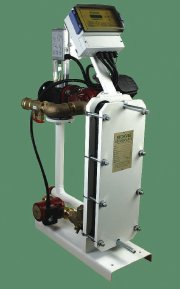Efficient hot water and space heating come on a plate

Compact and efficient hot-water service — a plate heat exchanger with a footprint about a metre square can satisfy the requirements of a 300-bedroom hotel. Compare that with the space required by a calorifier.
Modulating boilers and high efficiency heat exchangers have altered the face of commercial heating and hot water installations, says PAUL SANDSA series of technological advances in recent years has changed the way enlightened consultants and installers look at the design of commercial heating and hot-water systems.
Perception However, despite the fact that there are far more efficient and effective alternatives, there remains a perception among many that it is always better to separate hot water and heating in commercial premises. This is simply not the case. The high water content and minimum turndown ratio with older style boilers and calorifiers was associated with poor energy efficiency with boiler cycling and excessive standing losses. Modern boilers and plate heat exchangers offer the advantage of low water content and are fully modulating, which leads to the efficient production of heating and hot-water services. Our Econoflame premix boilers, for example, modulate on a frequency-inverter-controlled fan and pressure-controlled gas valve, greatly boosting their efficiency compared with a typical boiler set up. Many existing commercial installations comprise a large cast-iron sectional boiler feeding the demand of a calorifier, and off peak load tends to be small. This means that the boiler will be cycling on and off all the time, wasting valuable energy. In addition, the storage capacity of the calorifier — if it is excessive — leads to heat being leaked to the plant room, compounding energy wastage. Priority While it is true that a higher primary heating load is required for a system that includes a plate heat exchanger, this can easily be overcome by ensuring that hot water services take priority over the heating. Since even on a part load, the requirement for hot-water services can be quite high, boilers can be sized to ensure that a normal off-peak load falls within the modulation range of the boiler. Another argument put forward by those advocating separate hot-water and heating systems is that this system results in relatively low loads. In fact, although there are higher loads associated with using a plate heat exchanger, these are only applied for a relatively short period. Plate heat exchangers use the boiler capacity more effectively than an old fashioned boiler and calorifier set-up, which requires a lower load, but extending over a longer period. That means that a system based on a plate heat exchanger with low water content, fully modulating boilers is inherently more energy efficient than a system based on a boiler and calorifier. It is possible to go a step further in the quest for high efficiency by not just offering low-water-content fully modulating units, but also applying the condensing principles to both the hot-water and heating services. Package A recent innovation is the C Series Econoplate range of packaged plate heat exchangers, which are designed to operate with the lower flow and return temperatures provided by condensing boilers. They are available in three ranges — a total of some 50 units with outputs up to 742 kW. The units operate with primary flow temperatures of 70°C and achieve return temperatures around 45°C. In putting this package together with the correct flow temperature, it is now easier for specifiers to select condensing technology and meet energy-efficiency targets — including those in next year’s revision of Part L of the Building Regulations. If the return-water temperature to the boiler is above the dew point of the flue gas there is little point in specifying a condensing boiler. With a packaged plate heat exchanger coupled to a condensing boiler to provide the hot water services load, engineers can significantly increase the seasonal operating efficiency of a system. The Econoplate low-NOx system also has the advantage of qualifying for the Enhanced Capital Allowance. Paul Sands is with Stokvis Energy Systems, 96R Walton Road, East Molesey, Surrey KT8 0DL Summary of the benefits of plate heat exchangers for providing heating and hot-water services • Low water content reduces the risk of legionella breeding. • Compact for installing in tight spaces. For example, in a hotel installation in which we were involved, there were three calorifiers about 3 m diameter by 10 m long. We replaced them with three plate heat exchangers which stood in an area about 2 m square. Two plate heat exchangers with a footprint 1 m square would satisfy the hot-water-service requirements of a 300-bedroom hotel. • Easy to install and maintain (the plates simply unbolt, and can be removed). • Increasing the capacity is easy (simply by adding more plates). • The heat-transfer efficiency of plate heat exchangers is about 99%. Depending on the amount of storage the gas-fired units and calorifiers have and how they cycle on and off, the efficiency can vary from 50 to 70%. You can achieve a 20 to 50% saving on hot-water generation. • The capital cost of a plate heat exchanger system is higher than a system based on boilers and calorifiers, but the total cost of ownership is far lower given the amount of labour and materials, and lagging of the unit, plus the annual insurance checks that must be carried out. For direct gas-fired units, you have to fit multiple flues and multiple pipework to connect them; it becomes much more cost effective to specify plate heat exchangers.
Related links:


